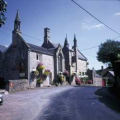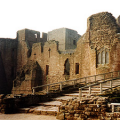
|
|||||

Life Changing Activi..
 Fun, adventure, and personal growth in the Great Outdoors Fun, adventure, and personal growth in the Great Outdoors
Gallery 54 - Ross on..
 Contemporary abstract art, ceramics and glassware Contemporary abstract art, ceramics and glassware
Hippo The Watersaver
 is the simple, proven and low cost water saving device to help conserve water i.. is the simple, proven and low cost water saving device to help conserve water i..
|
Goodrich
Not strictly in the Forest of Dean but close enough to count (especially with tourists, and historically, invaders!) Goodrich is a small village that grew up next to Goodrich Castle, a fine 'Marcher Castle' which stands on a high spur of land commanding strategic position above a ford, an important ancient crossing point of the Wye. The castle was begun c1101 and from1326 onwards was the family seat of the Earls of Shrewsbury, although by the 16th century it had passed into the hands of the Earls of Kent and was no longer inhabited on a permanent basis. In 1642, at the start of the civil war, Goodrich was seized by the Earl of Stamford for Parliament, but the surrounding countryside was against him and he withdrew. A Royalist force under Colonel So Henry Lingen occupied the castle and held it for four years, but after Hereford fell to Parliament in 1644, the garrison of Goodrich became rather isolated and in May 1646 Colonel John Birch, the Parliamentary commander of Hereford was given orders to advance on the castle and secure it. The castle walls however were unaffected by the Parliamentary cannon so Birch ordered that the castle's water supply be cut off and a siege mortar made to help in the attack. This weapon, which was capable of firing a 200lb /90kg explosive shell, was cast locally (ether at nearby Whitchuch or Lydbrook) and earned the nickname 'Roaring Meg' (it still survives today in the grounds of the Churchill Gardens Museum at Hereford). In mid June the weapon arrived and after being moved into a position, its first few rounds soon breached the South wall. By this time, conditions inside were desperate and when news reached the castle that the king had been captured, the defenders finally surrendered. After the Civil War, the castle was left uninhabitable and it remained in ruins unitil1920, when the last private owner placed it into the care of the Commissioners of the Works (now English Heritage), who carried out a preservation programme.
Nearby Accommodation
Nearby Attractions
|
||||
|
|
|||||


